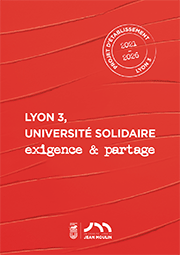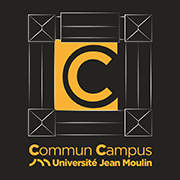AccueilRechercheProgrammes et productions scientifiquesThèsesThèses soutenuesThèses soutenues - 2006-2021Thèses soutenues - 2020
-
Partager cette page
- Recherche,
- Philosophie,
RICHARD Thomas
Prolégomènes à une herméneutique existentielle des antéformes architecturales
Publié le 30 janvier 2020 – Mis à jour le 3 mars 2021
Thèse en Philosophie, soutenue le 28 janvier 2020.
Dans l’historiographie contemporaine, le déconstructivisme constitue un moment significatif d’une expression négative de la forme. En effet, la morphologie architecturale met en vue une recomposition à partir d’une décomposition : elle affirme et présente un processus de négation. Comment comprendre ces formes architecturales paradoxales qui expriment leur propre abolition et quelles sont les différentes manifestations de cette négativité morphologique dans l’architecture contemporaine ? En effet, bien que se défendant de toute attention à la forme, les architectures qualifiées de non-rhétoriques par l’historien J. Lucan (A. Lacaton & J.-P. Vassal, OFFICE Kersten Geers David Van Severen etc.), en cherchant précisément à faire dispara?tre toute expressivité morphologique, ne participent-elles pas d’une même visée que le déconstructivisme, lequel opère ce retrait de la forme de manière explicite ?
Une première partie de cette recherche se propose d’explorer différentes approches d’architectes et de philosophes qui ont consacré une partie ou l’ensemble de leurs travaux à l’imagination et à la po?étique des formes : J. Lucan, D. Guibert, D. Raynaud, E. Cassirer, G. Bachelard, G. Durand. Dans une deuxième partie, dans le sillage de l’?uvre d’H. Maldiney qui établit un parallèle entre Art et existence, j’inscris ma recherche dans une herméneutique existentielle de ces formes négatives que j’ai nommées : antéformes. Mon hypothèse s’attache à proposer qu’au fondement négatif de notre rapport au monde répond une mise en forme négative des morphologies architecturales. En attaquant leur propre forme, c’est-à-dire le sens de la mise en forme proprement dite, les antéformes posent la question de ce qui fonde leur existence et y répondent en projetant dans l’objet une manière de se rapporter au monde. Certains concepteurs contemporains donnent à voir en partie et projettent à leur insu leur propre expérience vécue et désirante de la quête cherchante de forme qui les habite lors de la conception.
Dans cette recherche, je suggère ainsi d’établir une analogie entre l’état po?étique et l’expression d’une forme négativée de l’?uvre. En outre, je m’emploie à repérer, proposer et articuler dans une architectonique des antéformes, différentes modalités de néantisation de la forme architecturale pouvant correspondre à des styles ou orientations de la présence proposés par le philosophe. Je développe ainsi des schèmes stylistiques fondés sur des tendances pulsionnelles ou qualités énergétiques tensives. Enfin, je propose que les antéformes expriment un ?a-voir po?étique de la crise qui les fondent, les émotivent, et témoignent de cette épreuve surmontée.
Il s’agit ici de réactiver la double implication originaire du verbe po?en : à la fois accomplissement et novation. Tout travail po?étique, en tant qu’il demeure porté par une exigence de singularité, implique l’imprévisibilité de l’objet qui émergera de son processus de conception. Les antéformes sont un appel à concevoir au sens plein du terme tout autant qu’un appel à un rapport propre (authentique) à l’existence ; lequel s’envisage, non comme un Moi ou un cogito qui se pose, mais comme le processus d’individuation d’un Soi. Celui-ci ne peut exister sans un travail incessant de désindividuation préalable dont les antéformes sont le témoignage. L’acte po?étique invite, non à choisir parmi des possibles préalables, mais précisément à engendrer sa propre forme d’être au monde.
In contemporary historiography, deconstructivism is a significant moment in a negative expression of form. Indeed, architectural morphology puts forward a recomposition from a decomposition: it affirms and presents a process of negation. How can we understand these paradoxical architectural forms that express their own destruction? What are the different manifestations of this morphological negativity in contemporary architecture? Although defending themselves from any attention to forms, architectures described as non-rhetorical by the historian J. Lucan (A. Lacaton - J.-P. Vassal, OFFICE Kersten Geers David Van Severen, etc.), by seeking precisely to remove all morphological expressiveness, would they not participate, like deconstructivism, which removes forms explicitly?
First, we explore different approaches of architects and philosophers, such as J. Lucan, D. Guibert, D. Raynaud, E. Cassirer, G. Bachelard, G. Durand, who devoted some or all of their work to the imagination and the po?etics. Second, in the spirit of H. Maldiney, which draws a parallel between Art and existence, I build my work on the existential hermeneutics of these negative forms, which I have named: antéformes. My hypothesis is that the negative basis of our relationship to the world responds to a negative shaping of architectural morphologies. By attacking their own form, that is to say the manner in which they are shaped, the antéformes question their own existence and respond to it by projecting into the object a way of relating to the world. Some contemporary designers partially reveal and project their own experience of searching for the form, that drives them during conception.
In this research, I suggest an analogy between the poietic state and the expression of a negative form of the work. Besides, I work to identify, propose and articulate in an architectonic of the antéformes, different aspects of the nothingness of the architectural form that may correspond to styles or orientations of presence proposed by philosophers. I thus develop stylistic schemes based on drive tendencies or tensile energy qualities. Finally, I propose that the antéformes express a poietic sense of crisis that melts them, emotes them, and testifies to this experience.
The aim here is to reactivate the dual implication originating from the poien verb : at once accomplishment and novation. Any poetic work, as it remains driven by a requirement of singularity, implies the unpredictability of the object that will emerge from its design process. The antéformes are a call to conceive in the full sense of the word as well as a call for a proper (authentic) relationship to existence; which sees itself, not as the emerge of the self or cogito, but as the process of individuation of a Self. This one can not exist without an incessant work of preliminary désindividuation for which antéformes are the testimony. The poietic act invites, not to choose among possible prerequisites, but precisely to generate its own form of being in the world.
Une première partie de cette recherche se propose d’explorer différentes approches d’architectes et de philosophes qui ont consacré une partie ou l’ensemble de leurs travaux à l’imagination et à la po?étique des formes : J. Lucan, D. Guibert, D. Raynaud, E. Cassirer, G. Bachelard, G. Durand. Dans une deuxième partie, dans le sillage de l’?uvre d’H. Maldiney qui établit un parallèle entre Art et existence, j’inscris ma recherche dans une herméneutique existentielle de ces formes négatives que j’ai nommées : antéformes. Mon hypothèse s’attache à proposer qu’au fondement négatif de notre rapport au monde répond une mise en forme négative des morphologies architecturales. En attaquant leur propre forme, c’est-à-dire le sens de la mise en forme proprement dite, les antéformes posent la question de ce qui fonde leur existence et y répondent en projetant dans l’objet une manière de se rapporter au monde. Certains concepteurs contemporains donnent à voir en partie et projettent à leur insu leur propre expérience vécue et désirante de la quête cherchante de forme qui les habite lors de la conception.
Dans cette recherche, je suggère ainsi d’établir une analogie entre l’état po?étique et l’expression d’une forme négativée de l’?uvre. En outre, je m’emploie à repérer, proposer et articuler dans une architectonique des antéformes, différentes modalités de néantisation de la forme architecturale pouvant correspondre à des styles ou orientations de la présence proposés par le philosophe. Je développe ainsi des schèmes stylistiques fondés sur des tendances pulsionnelles ou qualités énergétiques tensives. Enfin, je propose que les antéformes expriment un ?a-voir po?étique de la crise qui les fondent, les émotivent, et témoignent de cette épreuve surmontée.
Il s’agit ici de réactiver la double implication originaire du verbe po?en : à la fois accomplissement et novation. Tout travail po?étique, en tant qu’il demeure porté par une exigence de singularité, implique l’imprévisibilité de l’objet qui émergera de son processus de conception. Les antéformes sont un appel à concevoir au sens plein du terme tout autant qu’un appel à un rapport propre (authentique) à l’existence ; lequel s’envisage, non comme un Moi ou un cogito qui se pose, mais comme le processus d’individuation d’un Soi. Celui-ci ne peut exister sans un travail incessant de désindividuation préalable dont les antéformes sont le témoignage. L’acte po?étique invite, non à choisir parmi des possibles préalables, mais précisément à engendrer sa propre forme d’être au monde.
In contemporary historiography, deconstructivism is a significant moment in a negative expression of form. Indeed, architectural morphology puts forward a recomposition from a decomposition: it affirms and presents a process of negation. How can we understand these paradoxical architectural forms that express their own destruction? What are the different manifestations of this morphological negativity in contemporary architecture? Although defending themselves from any attention to forms, architectures described as non-rhetorical by the historian J. Lucan (A. Lacaton - J.-P. Vassal, OFFICE Kersten Geers David Van Severen, etc.), by seeking precisely to remove all morphological expressiveness, would they not participate, like deconstructivism, which removes forms explicitly?
First, we explore different approaches of architects and philosophers, such as J. Lucan, D. Guibert, D. Raynaud, E. Cassirer, G. Bachelard, G. Durand, who devoted some or all of their work to the imagination and the po?etics. Second, in the spirit of H. Maldiney, which draws a parallel between Art and existence, I build my work on the existential hermeneutics of these negative forms, which I have named: antéformes. My hypothesis is that the negative basis of our relationship to the world responds to a negative shaping of architectural morphologies. By attacking their own form, that is to say the manner in which they are shaped, the antéformes question their own existence and respond to it by projecting into the object a way of relating to the world. Some contemporary designers partially reveal and project their own experience of searching for the form, that drives them during conception.
In this research, I suggest an analogy between the poietic state and the expression of a negative form of the work. Besides, I work to identify, propose and articulate in an architectonic of the antéformes, different aspects of the nothingness of the architectural form that may correspond to styles or orientations of presence proposed by philosophers. I thus develop stylistic schemes based on drive tendencies or tensile energy qualities. Finally, I propose that the antéformes express a poietic sense of crisis that melts them, emotes them, and testifies to this experience.
The aim here is to reactivate the dual implication originating from the poien verb : at once accomplishment and novation. Any poetic work, as it remains driven by a requirement of singularity, implies the unpredictability of the object that will emerge from its design process. The antéformes are a call to conceive in the full sense of the word as well as a call for a proper (authentic) relationship to existence; which sees itself, not as the emerge of the self or cogito, but as the process of individuation of a Self. This one can not exist without an incessant work of preliminary désindividuation for which antéformes are the testimony. The poietic act invites, not to choose among possible prerequisites, but precisely to generate its own form of being in the world.
Mots-clés : antéforme, archa?sme architectural, architectonique, déconstructivisme architectural, herméneutique existentielle, idéalisme architectural, neutre architectural, po?étique architecturale, processus de conception architectural, pulsion, stylistique architecturale.
Keywords : antéformes, architectural archaism, architectonic, architectural deconstructivism, existential hermeneutics, architectural idealism, architectural neutrality, architectural poietic, architectural design process, drive, architectural stylistics.
Keywords : antéformes, architectural archaism, architectonic, architectural deconstructivism, existential hermeneutics, architectural idealism, architectural neutrality, architectural poietic, architectural design process, drive, architectural stylistics.
Directeur de thèse : Jean-Jacques WUNENBERGER
Membres du jury :
- M. Jean-Jacques WUNENBERGER, Directeur de thèse, Professeur des universités émérite, Université Jean Moulin Lyon 3,
- M. Artur ROZESTRATEN, Ma?tre de conférences habilité à diriger des recherches, Faculdade de Arquitetura e Urbanismo da Universidade de S?o Paulo (FAUUSP),
- Mme Chris YOUNES, Professeure habilitée à diriger des recherches, Ecole Spéciale d’Architecture, Paris,
- M. Jean-Philippe PIERRON, Professeur des universités, université de Bourgogne, Dijon,
- Mme Julie CATTANT, Ma?tre de conférences, Ecole nationale supérieure Architecture, Lyon.
Présidente du jury : Jean Philippe PIERRON
Documentation
Mise à jour : 3 mars 2021






